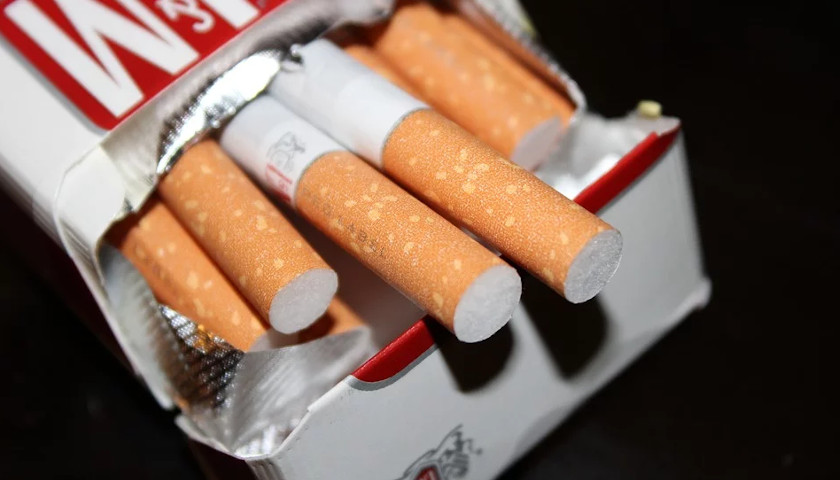by Bethany Blankley
As cigarette taxes have risen across the country, so too has cigarette smuggling across state lines, causing billions of dollars of tax revenue losses for high-tax states.
That’s according to reports from the Washington, D.C.-based Tax Foundation and a yearly analysis by the Michigan-based Mackinac Center for Public Policy.
According to the Tax Foundation’s new analysis, cigarette tax rates increased in 37 states and the District of Columbia between 2006 and 2017. These tax hikes have helped create a “black and gray market movement of tobacco products into high-tax states from low-tax states or foreign sources,” the foundation says.
Store owners, or buyers, travel to low-tax states to buy cigarettes at lower-taxed rates and travel back to their high-taxed state to sell them to customers for cash on the black market.
According to the report, New Hampshire has the greatest number of outbound smuggled cigarettes, known as “butt-legged,” accounting for 65 percent of consumption. The next-highest outbound smuggling occurred in Delaware (40.6 percent), Idaho (26.8 percent), Virginia (24.2 percent), and Wyoming (22.4 percent).
The greatest number of inbound contraband occurs in New York, an estimated 55.4 percent, based on 2017 data. The next-highest inbound smuggling occurred in California (44.6 percent), Washington (42.8 percent), New Mexico (40.8 percent), and Minnesota (34.6 percent).
New York’s state cigarette tax is $4.35 per pack, and the city’s additional tax is $1.50 per pack, leaving city residents to pay $5.85 in taxes alone per pack, more than what a pack of cigarettes cost 20 years ago.
As the cigarette tax in New York increased by 190 percent since 2006, smuggling increased by 55 percent, the Mackinac Center estimates.
According to the National Research Council and the Institute of Medicine, New York’s cigarette tax losses account for roughly half of state tax losses nationwide. The Voice estimated that New York loses more than $1.5 billion every year to tobacco tax evasion.
“The crafting of tax policy can never be divorced from an understanding of the law of unintended consequences, but it is too often disregarded or misunderstood in political debate, and sometimes policies, however well-intentioned, have unintended consequences that outweigh their benefits,” Ulrik Boesen, Tax Foundation senior policy analyst, said.
Scholars at the Mackinac Center used a statistical analysis to estimate smuggling rates for each state. The most recent report is based on 2017 data, which found that smuggling rates generally rose in states after they adopted cigarette tax increases.
The study compares legal-paid sales of cigarettes in each state with smoking rates in each state. It also explains the difference between the number of cigarettes smoked and volume of legal sales, and estimates possible illicit imports from Mexico and exports to Canada.
In Pennsylvania, for example, after a $1 cigarette tax increase in early 2016, the state experienced a significant increase in smuggling, the center found.
In 2015, Pennsylvania’s outbound smuggling was 2 percent, but after the 2016 tax increase its inbound smuggling rose to 14.7 percent. Over the same period, outbound smuggling increased in nearby low-tax Delaware, from 20.3 percent to 40.6 percent.
The Voice’s Jon Campbell argues that high taxes aren’t the cause of butt-legging. “… it’s not necessarily the high taxes that drive the problem,” he says. “It’s the tax rate differential among the states that makes room for smuggling to occur.”
“But tax ‘harmonization’ – eliminating the disparity between tax rates in various jurisdictions – economists will tell you, is the first and last step in putting a stop to the problem,” Cambell adds. “A reduction and alignment of provincial taxes in Canada, beginning in the mid-Nineties, dramatically reduced the smuggling problem that once existed there, though it has been creeping back up in recent years as the rates have again become unbalanced.”
In response, Boesen told The Center Square, “both the high level of taxation as well as the price differential between the states should be blamed for the high levels of interstate tobacco smuggling. While it would seem obvious that alignment of tobacco prices in, for instance, New Jersey and New York, would eliminate interstate smuggling between the two, it does not guarantee that tobacco products from other sources won’t be smuggled. This is happening all over the world with both authentic and counterfeit products.”
The underlying problem, the Tax Foundation argues, is that high cigarette taxes “amount to a ‘price prohibition’ of the product in many U.S. states.” In order to reduce interstate smuggling, the Mackinac Center argues, “high-tax states need to reduce their cigarette taxes.”
– – –
Bethany Blankley is a contributor to The Center Square.





